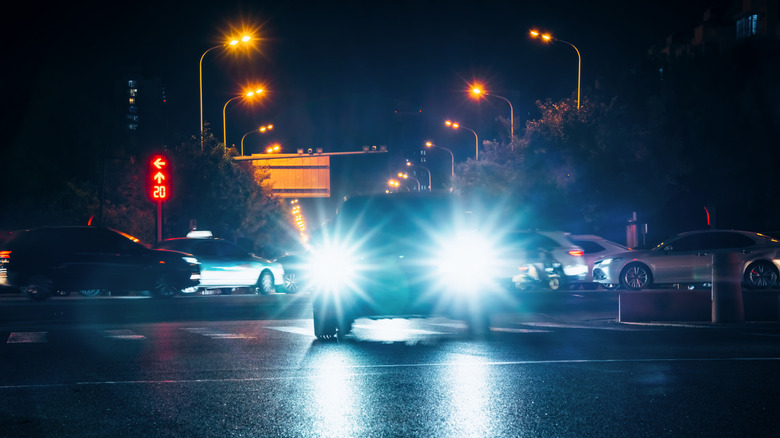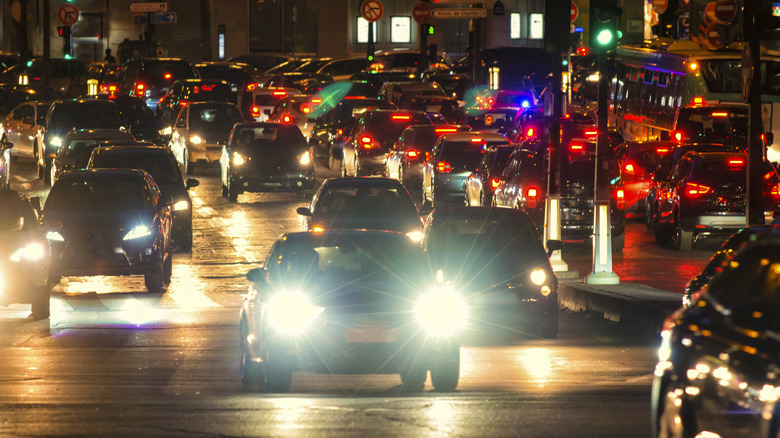Your Aftermarket Headlights Might Be Breaking Massachusetts Law
Thanks to the mass-adoption of LED and HID headlights on passenger cars, the roads at night have become an ever-brighter and paradoxically increasingly dangerous world. Whether it's people who leave their high-beams on or those who swap their factory beams for aftermarket units that are far more powerful, driving on busy streets at night can be a headache-inducing nightmare for people suffering from eye strain and migraines. But all that's about to change in Massachusetts, thanks to newly amended standards on vehicle lighting applicable to cars, trucks, public transit, and motorcycles.
These regulations specify various guidelines related to OEM and aftermarket headlamps and other lighting equipment, such as reflective devices, overhead lights, and so on. According to the Code of Federal Regulations, "The purpose of this standard is to reduce traffic accidents and deaths and injuries resulting from traffic accidents, by providing adequate illumination of the roadway, and by enhancing the conspicuity of motor vehicles on the public roads so that their presence is perceived and their signals understood, both in daylight and in darkness or other conditions of reduced visibility." However, it doesn't state that overly bright headlights are illegal, just misaligned ones. Except in this highly specific example: namely, aftermarket LED lights.
Here's the short version of the problem: headlights are rated for their legality as one complete unit, while no LED bulb is currently permitted to be used in a replaceable bulb headlight. In other words, if your car came with LEDs from the factory, that's fine. But they're not legally allowed as upgrades in original housings; let's break down exactly why, starting with the documents themselves.
The letter of the law
The law itself is filed under CFR Title 49, Chapter V, Part 571.108 covering "Lamps, reflective devices, and associated equipment." It applies to passenger cars, MPVs, trucks, most trailers, buses, and motorcycles, stating first and foremost that the number and types of lamps affixed to these vehicles must conform to recommendations set by SAE (Society of Automotive Engineers) publications. The standards don't directly reference a lumen-count as such, but rather focus on lighting pattern and visibility requirements.
The specific details are quite lengthy, from page 377 to 501 of Title 49, so let's briefly summarize it to the important facts. Various tables illustrate the positioning, coloration, and correct orientation of headlights, most of which are common-sense: don't have headlights over a certain height, the outermost lights are the low-beams and the inner ones are high-beams to help identify a car's width at night, and so on.
The NHTSA states that such lights may be LEDs in OEM vehicles if they're wired in such a way that if one diode fails, they all stop functioning. It further defines what exactly an integral-beam headlamp is, including the bulb and housing elements. The bulb itself can be replaced, but only if it meets specific requirements. As of June 2025, those requirements now include LED lights replacing standard halogen bulbs because the original housing, orientation, and position on the vehicle was designed for lower-output halogen lights. Driving with these units fitted can result in a fine, similar to driving with improperly adjusted lights. For the people on the other end, here are some tips on reducing the glare caused by misaligned and overly bright lights.
But why ban LED conversions at all?
Anyone driving at night can attest to the difference in brightness between older-model and brand-new headlights. LEDs are praised for their brightness, longevity, and utility, plus people purchase them because they look newer. But that brightness comes at a cost: namely, if they're misaligned or the vehicle sits too high, then the light shines right into other people's eyes and ruins night-vision for other drivers. That's why the entire housing must be tested no matter whether it's a halogen, HID, or LED setup. A standard LED bulb doesn't work with a halogen housing because while the two may be compatible from a mechanical perspective, they each feature different brightness levels and housing geometry. In other words, you need a new housing bowl to accommodate the LED assembly.
Because the law focuses on certifications, it's a gross overstatement to say that all LED conversions are banned. More specifically, what's banned is when you put an LED in without changing anything else. So if you're upgrading to LED lights, you need to bear all this in mind: either fit the car with the factory-rated lights, or change out the entire headlight assembly to one designed from the outset to use HIDs or LEDs. Because this law is meant to keep excessive glare from occurring, the easiest and most important factor to consider in any car — factory LED or not, is to make sure they're properly adjusted so they don't blind other drivers.


